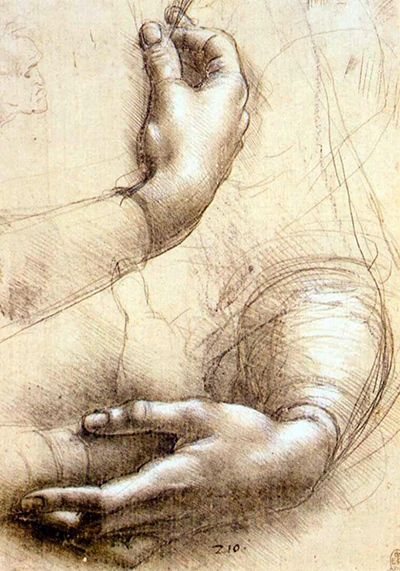The original image is part of The Royal Collection, housed in Windsor Castle, England. Da Vinci was fascinated by human anatomy both as an artist and as a scientist.
The majority of his surviving anatomical drawings are also in The Royal Collection. They were acquired by the Earl of Arundel and brought to England around 1640.
Da Vinci's skill in anatomical drawing was beyond most people's comprehension at the time. Compared to some of his sectional drawings of muscles, ligament and bones, these female hands might seem rather simplistic.
However, they are anatomically correct and wonderfully detailed with careful muscle definition and meticulous attention to the creasing on the joints. The dark cross-hatching and white highlights show da Vinci's excellent use of light and shadow. The female hands also predate da Vinci's first studies in anatomy and dissection.
The image is intriguing for a number of reasons. There are, in fact, three hands within this study of hands. The bottom hand is drawn as if it is resting on a lap.
The top hand appears to be holding a sprig or a veil between the thumb and forefinger. Underneath the top hand is a "ghost hand" possibly showing da Vinci's first thoughts about the positioning of the hand.
Even so, this hand is drawn confidently. For some reason there is also a lightly sketched caricature or grotesque face of a man to the top right of the image.
It is not known if this was simply a study of female hands or a preparatory sketch for a portrait. Some people believe it could be a preparatory drawing of da Vinci's Lady with an Ermine, Cecilia Gallerani.
Although the hand position is not the same as shown in her completed portrait, the female hands share the same slender features. It has also been proposed that they could be the hands that would have originally appeared in the painting of Ginevra de Benci, also painted around 1474.
The bottom section of this portrait is missing but art historians feel that the hands and arms would have been shown. Certainly these female hands could have been in used one of da Vinci's favoured three-quarter profile portraits.
Whoever these female hands belonged to, they are simply a stunning reminder of da Vinci's magnificence and legacy.


